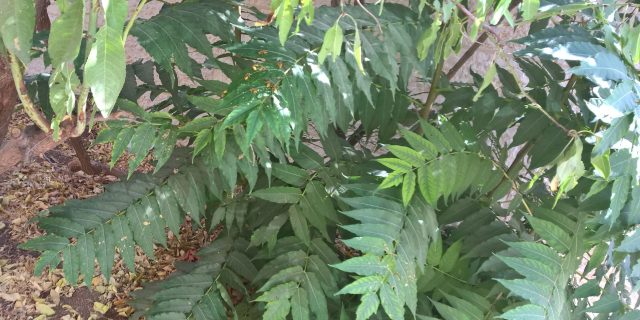22
Dec
Researchers Find Nonchemical Biological Control When “Tree of Heaven” Is Being Managed

(Beyond Pesticides, December 22, 2021) A promising new biocontrol agent for the tree of heaven (Ailanthus altissima)—considered an invasive species in the U.S. and Europe by some—was recently discovered by French-based scientists at the U.S. Department of Agriculture. The finding centers on a small mite of the Eriophyidae family, Aculus mosoniensis, which has been found to feed on tree of heaven. The finding is encouraging for the future management of this species in conjuction with balanced ecosystems. “In Europe, this Eriophyid mite is considered one of the most promising biological control agents of tree-of-heaven,” said Javid Kashefi, senior support scientist at the European Biological Control Laboratory (EBCL) in France. “This finding provides encouraging evidence that the geographic occurrence of this species is expanding in the continent.”
Tree of heaven is a fast-growing deciduous tree native to Asia that has spread throughout Europe and North America. First introduced in the 1700s as a shade tree, it was appreciated for its quick growing ability and low propensity for insect damage, but quickly became problematic. Researchers identify five traits that warrant its classification as ‘invasive,’ including its ability to tolerate extreme environmental conditions, produce hundreds of alleopathic compounds (which harm, or inhibit the growth of nearby plants), bear abundant seeds with excellent viability, reproduce from its roots through sprouting and cutting, and escape nearly all herbivorous predators outside of its native range.
These characteristics provide Ailanthus altissima the ability to rapidly crowd out native species, particularly in ecosystems already experiencing some level of disturbance. In the built environment, because of its cosmopolitan nature and ability to grow in the smallest of spaces, it causes problems ranging from broken sewer lines to damaged ditches, sidewalks, and house foundations. The tree poses a growing threat to agriculture, increasingly invading French wine vineyards. In addition to its alleopathic ability to kill and suppress nearby vegetation, the tree functions as a preferred host for the spotted lanternfly, another organism native to the Asian continent. Spotted lanterfly, a major pest of fruit trees and vineyards, was first discovered in Pennsylvania in 2014, and has spread rapidly, with current detections ranging west from Indiana to Massachusetts, and southward into central Virginia.
Researchers analyzed mite infested leaves on tree of heaven found in France in mid to late 2020, after first finding presence of the insect farther east in Hungary and Italy near the end of the last decade. Positive identification based on various characteristics confirmed the presence of Aculus mosoniensis, an herbivorous mite native to tree of heaven’s home range that forms dense populations on the underside of young plant leaves. Affected trees experience leaf curl, yellowing, and premature leaf loss. Heavily infested trees also experience limb drying. These findings represented the first evidence for the presence of this mite in France, and scientists see this insect as a potential biocontrol agent to replace toxic chemical use. The mite’s ability to expand geographically and close association with its target plant covers two important characteristics of a potential biocontrol: wide dispersal and host-specificity.
Apart from A. mosoniensis, there is one other potential biocontrol for tree of heaven, a pathogen that causes wilting, known as Verticillium dahlia, which was recently discovered in Italy. Biological controls like these represent a viable pest management approach that does not employ highly toxic chemical pesticides. It is common to read recommendations for tree of heaven management that suggest the use of carcinogenic chemicals like glyphosate. However, even “minor” applications that, for instance, suggest painting tree stumps with Roundup or another similar product present health risks to the applicator and ecological risks to the local environment. Although mechanical management, primarily in the form of consistent sprout and root pulling for tree of heaven, can be labor intensive, it represents a safer approach than handling toxic chemicals. Whatever one’s approach may be to eliminating tree of heaven on one’s property, it is critically important to consider the conditions that allowed the plant to colonize an area in the first place, and have a plan to replace the area where the tree system was uprooted with native species. While tree of heaven has the ability to displace native species, a healthy, functioning native ecosystem makes success much more difficult for the plant.
Biocontrols like A. mosoniensis can provide wide area solutions for widespreading plants like the tree of heaven. According to a study published in late 2020, biocontrol agents have added billions in benefits to economies, particularly in agriculture, providing critical solutions and “durable pest control” throughout the globe. Rather than have humans function as crude predators armed with chemical weapons in degraded ecosystems, biological controls provide a targeted approach that works with natural processes. For information and approaches to safer pest management, see Beyond Pesticide ManageSafe webpage. And for more on the issue of ‘invasive’ or opportunistic species see the page on Ecological Management of Problem Vegetation.
All unattributed positions and opinions in this piece are those of Beyond Pesticides.
Source: USDA press release, Phytoparasitica










